
In August 2019 the Glen Ample Estate submitted a Prior Notification to widen a section of the core path through the glen for forestry purposes. The core path forms part of the popular walking route from Loch Lubnaig to Beinn Each and the Munro, Stuc a Chroin. The Loch Lomond and Trossachs National Park Authority granted approval seven months later in April 2020 but work appears to have been delayed due to Covid and only started this year. While still “work in progress” the photos raise serious concerns.

While the block of forestry is on the Glen Ample estate, the Land Registry shows all the other forestry to the south and east of Creag a Gheata is on the Ardchullarie estate. Access will therefore be through that estate. The Construction Method Statement (see here) which accompanied the “notification” states that having considered “many different routes”, this was the preferred option:
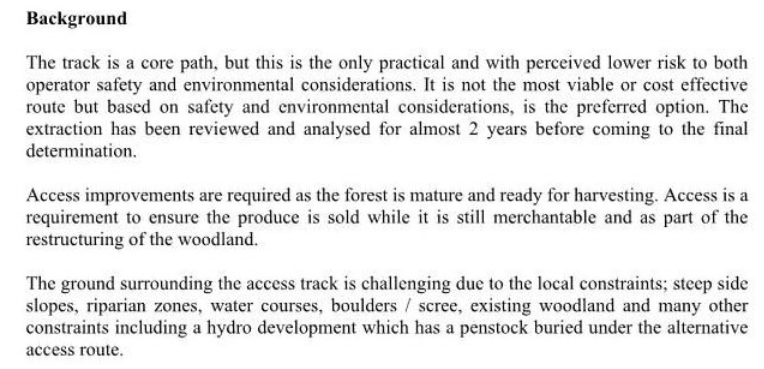
As the first photo shows, the route is indeed challenging. This appears to have prompted the LLTNPA planners to require the Glen Ample Estate to request a screening opinion of whether a Forestry Environment Impact Assessment (EIA) was required. The planning report indicates that:
“an EIA was not requested by Forestry Land Scotland as the mitigation measures outlined in the Screening Opinion (and to be covered through conditions for avoidance of doubt) were considered sufficient in this instance.”
The reference to “Forestry Land Scotland” appears to be a mistake as it is Scottish Forestry, not Forestry and Land Scotland, which is responsible for taking decisions about forestry EIAs (see here for explanation forestry EIAs). The Screening Opinion has not been made public on the LLTNPA’s planning portal (I have requested it under Freedom of Information) but the evidence on the ground suggests that Scottish Forestry got it badly wrong:
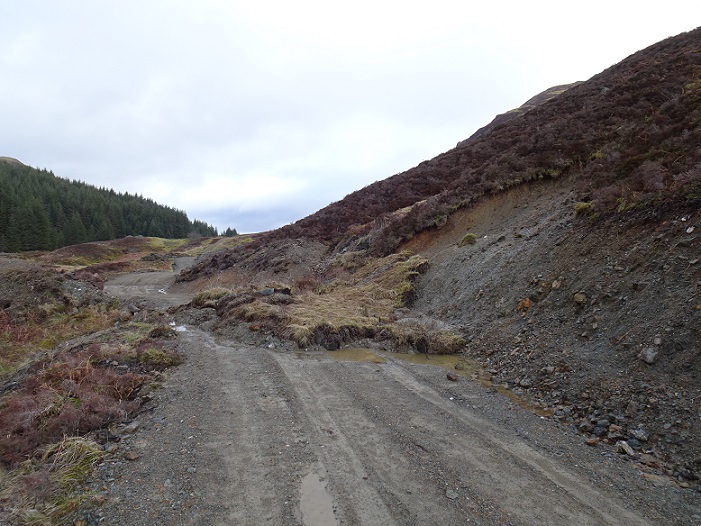
The landslip shows that the measures proposed by the Glen Ample estate to mitigate the impact of the track construction were clearly insufficient. A full EIA by qualified professionals might have highlighted these risks and prompted consideration of whether this was a viable route for forest harvesting purposes. But instead, judging by the fact that it took from August to February for the Screening Opinion to be produced, it appears that Scottish Forestry negotiated with the estate behind the scenes on how to mitigate the risks and avoid the need for an EIA. The process appears all to similar to what happened at Ross Priory where the LLTNPA helped the Hunter Foundation avoid the need for an EIA by agreeing a set of mitigation measures (see here).
The photo demonstrates that neither the developers nor the planners are qualified to decide whether mitigation works will be effective or not and that, without the input of independent expert opinion in cases such as this, disasters are likely.
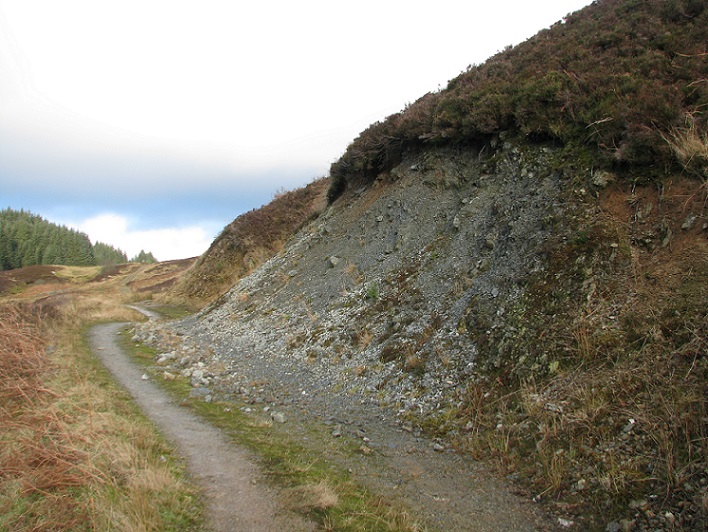
Prior to the Notification being submitted to the LLTNPA, there was evidence along this section of track that cutting more batters into the steep slope would create problems and be very difficult to restore. Perhaps that contributed – along with this being a core path (see here for map) – to the LLTNPA’s decision to require the Glen Ample Estate to seek approval for this track? That is more than what they require in most Prior Notification cases (see here). The need for Prior Approval should have been reinforced by the LLTNPA’s own policy on access tracks to renewable energy developments (see here). While not referred to in the LLTNPA’s report, this states that construction across steep hillsides should generally be avoided unless the angle of the batters can be re-graded to allow vegetation re-growth.
The Planning report and Decision Notice do both rightly recognise that this is a sensitive area in landscape terms (all the National Park should be!). As a consequence the new 90m extension, to link the northern end of the upgraded track with the forestry block, is “to be removed within 6 months of the completion of felling” , while the 690m of permanent track is “to be reduced in width to the existing width and condition”. The problem, however, is that both these conditions are accompanied by a let out clause:
“unless otherwise agreed with the planning authority” .
Why say that? This appears to be an invitation to the Glenample Estate to ask for the condition to be varied in future and undermines its stated rationale:
“it was discussed that the existing track which is to be widened must be restored to the current width in order to ameliorate landscape impacts. It is not considered that the increased width is required for either recreation access or estate management. This restoration should take the form of reducing the width of the running surface by use of soil and turf and the centre line of the reduced running surface should be roughed up to enable natural seeding and re-establishment of the centre green strip which is currently present.”
It is predictable that the estate will ask to vary the planning conditions once they realise just how challenging and expensive it will be to restore the newly cut batters. The issues are well illustrated by comparing what is said in the construction method statement (CMS) with the evidence on the ground.

And this is how the first section of 1m widening appeared a month ago:

While the batter in the background is too steep to re-vegetate, it is relatively low and there appears to be sufficient (brown) material stored on the right of the track to restore the original profile. Whether the slope in the foreground (grey) can be successfully restored is another question.
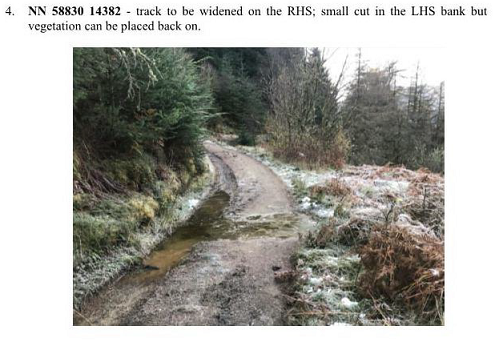
This is how the small cut in the left bank appeared last month:
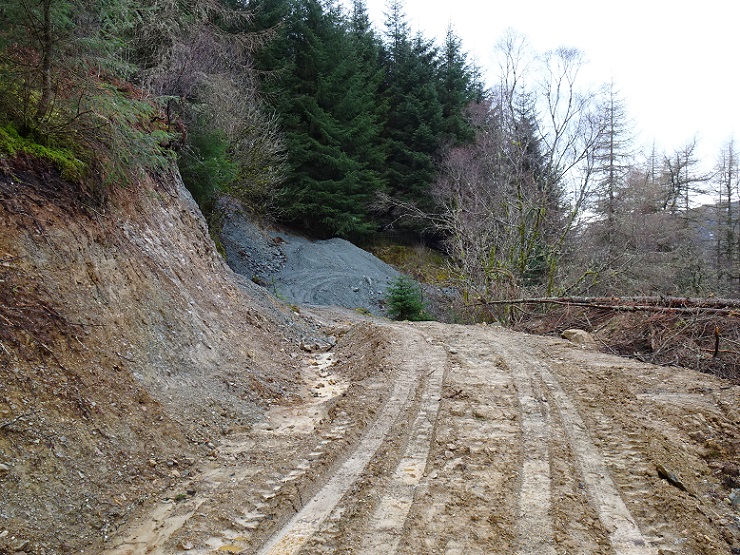
Is this really a small cut? It may be possible to re-use the material from the bank, which appears to have been spread over the track thereby raising it, in order to restore it to an angle where vegetation will grow. But it will take a lot of skilled work and there will be high risk of any soil placed against the bank slumping or slipping as a result of water draining off the slope. Jane Meek’s view, which I suspect is right, is that any restoration is “no more likely to last than a heap of sand patted into shape and held together by wishes and prayers”.
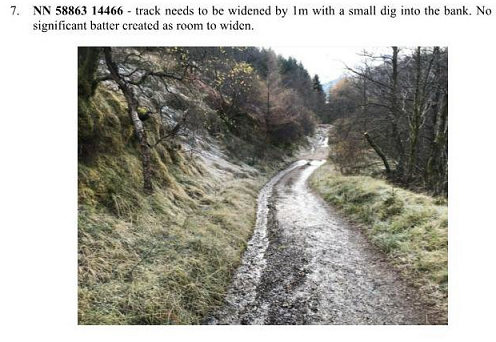
Another small dig:
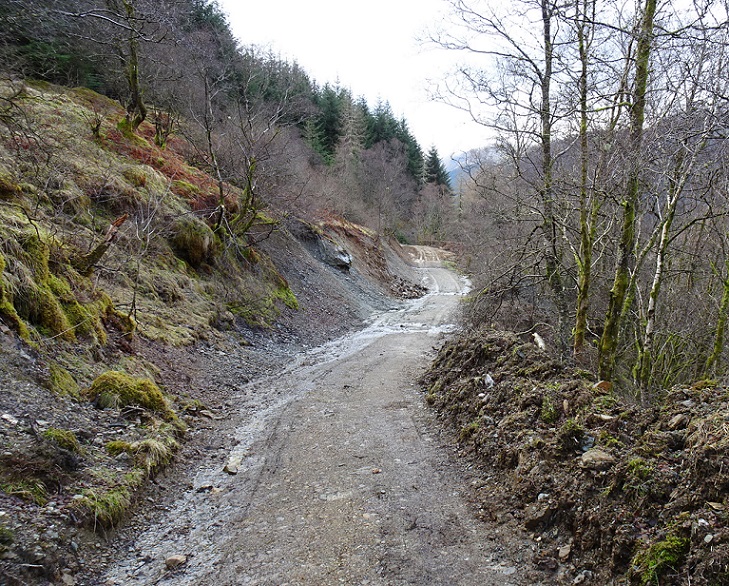
Did the LLTNPA anticipate this would happen as a result of the information in the Construction Method Statement? There was no requirement in the Decision Notice for the developer to mark out accurately on the ground the extent of the ground works. Were LLTNPA staff allowed to meet with the contractors on site before the work began or monitor the work during construction? The LLTNPA Decision Notice required the developer to submit a monitoring report within a month of the track being widened, far too late to prevent unnecessary damage being caused.
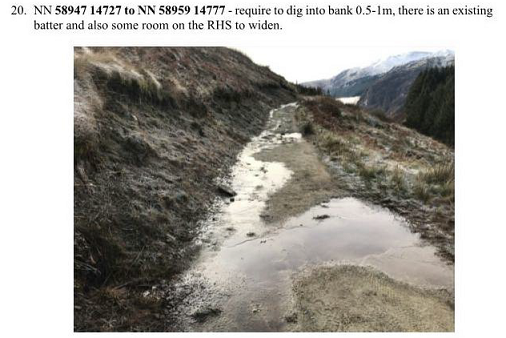
The LLTNPA’s Decision Notice also required Glenample Estates to restore the track to its current state, not to restore past damage – a lost opportunity which opens the door to half-hearted attempts at restoration.
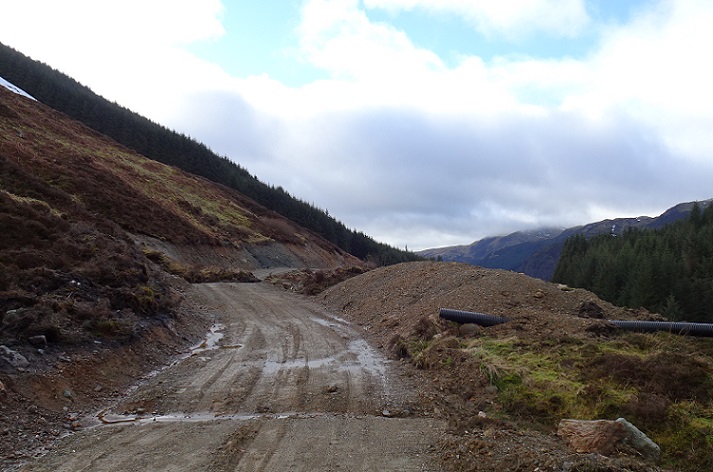
Last August I blogged about three new tracks in the National Park, including the hydro track at the far end of Glen Ample (see here). That same day wrote to James Stuart, the Convener of the LLTNPA, asking him to investigate the issues On 1st October I received an email from the LLTNPA stating my letter had been passed to the Planning Team. I eventually got a response on 22nd December (see here). This is what they said about Glen Ample:


If monitoring of this scheme was so well in hand, why did it take the LLTNPA almost three months to respond to my email. If a monitoring visit had already been scheduled for 15th September, one wonders why the LLTNPA couldn’t have thanked me for drawing these issues to their attention and undertaken to check them at the visit that was due in two weeks time?
The reason that didn’t happen has, I suspect, nothing to do with frontline staff but rather with the leadership of the National Park and its senior managers. While managers claimed the removal of the pipe from the turves showed that LLTNPA monitoring is effective, I would suggest it shows the opposite. Developers and contractors know they can get away with contravening Construction Method Statements, so have no incentive to do even the basis things right. The question the LLTNPA should have asked is how many other conditions were breached in the period between their two visits?
The wider issues about the planning of forestry tracks
A walk through Glen Ample in the Autumn should be enough to ascertain how far both the hydro and forestry track have been successfully restored and whether the LLTNPA’s claims are justified or not. Of the two, I suspect the forestry track will be the hardest to restore because of the steepness of the slope it traverses, but I will be surprised if there are not problems with both tracks.
Let us suppose the route along the core path was indeed the only viable one. That raises the question whether the block of forestry that is now ready for felling should ever have been planted in the first place. The decision about that preceded the creation National Park, but there is a lesson here which should be applied to all planning for new forestry. Access tracks should be considered and designed into forestry schemes before they are approved or planted. That way, the tracks can be designed to fit with the landscape and, as the trees grow, they are then hidden. This was the intention behind the Glen Feshie Estate’s proposals for a new network of tracks (see here) before this got caught up in a planning bungle by the Cairngorms National Park Authority.
Glen Feshie, too, is building narrower tracks to extract trees and it can do this because its using smaller machinery. The LLTNPA does not appear to have even considered that option here.
The LLTNPA has had at least two further opportunities since it was created to mitigate this lack of forethought. The first was through working with landowners to produce estate wide plans. Had it done so, it might have identified that felling this block of forestry would have presented real challenges and agreed as part of that that only smaller machinery could be required. The second was when the neighbouring Ardchullarie Estate submitted their planning application for a hydro scheme (see here) (see map). This provided an opportunity to design in an alternative access route to the forest block, “planning gain”. Instead, the information in the Prior Notification as quoted above suggests that the installation of the hydro pipe made use of this alternative route impossible (presumably because the track above the pipe was not robust enough to carry timber lorries).
Our National Parks were set up to encourage joined up thinking and conservation at the landscape scale. The Glen Ample forest track provides an example of how the LLTNPA, due to the way its currently run, is managing to achieve the opposite.

Many mature plantations across the Highlands, harvested today, were established 50-60 years ago. Hillsides were first fenced, deer culled, then planted by hand, after a forestry plough had been used to break through old ice age galcial subsoils and expose fresh minerals on free draining humps. These huge ploughs were dragged by small D4 and D6 bulldozers usually minus blade.( hardly the size of a modern SUV) These “state of the art” tracklayers were equipped with powerful rear winches, so if bogged or jammed in rock the plough could be recovered from a fresh angle. The slopes and inclines they managed to work were awe-inspiring. The only limitation to any plantation plough was the 800ft contour above which it was considered uneconomic to venture : trees would grow too slow. Teams were delivered to the plantations by van, minibus and 7.5 ton truck. Then they walked… and carried. Helicopters were very occasionally used in some remote places to drop bundles of seedlings for the planting teams high on hillsides to speed the process. It was back breaking work. (Good money for students in holiday periods! ) At that period commercial timber extraction might have involved horses, long winch cables and aerial drag lifts.
Today we are so much wiser ? Now it has to be seen as economic to take a ‘motorway-enabled’ 40 ton 6 axle articulated lorry complete with its own crane high onto the hills. For these machines full scale well graded roads are required. Excavators carve fresh lines into areas that had regained peace and a new eco-balance, cutting into ancient soils and screes along which agile, tracked forestry forwarders ( with drivers no less skilled or brave than their grandfathers generation) now can reach every tree, and all to casually, almost incidentally, trash the hillsides.
What an uncaring generation we have become? For every problem there is an ingenious hydraulically propelled solution, except for one . The preservation of the final vestiges of natural heritage of Scotland has no touch pad engineering quick fix. We may only guess now at the reaction of those who survived WW2,( the generation raised at the very start of mechanised agriculture) to see the calamity they actually seeded, the burgeoning legacy our generation has to sort out. The potential wholesale destruction of the ecology was not on their radar.. Our age’s forestry extraction “battlefields” – the pristine wild places for which that earlier generation in effect passed the death sentence – the price they could never have to witness.
To ensure a national supply of timber, and avert such a shortage of timber ever again, this cycle of destruction was set in train so long ago. The growth has happened so slowly and change so gradual it lay beyond perception of most people. Yet some of us ( of a certain age now, are seeing again the contours of hillsides on which as a child we saw forestry ploughs “playing” so many decades ago…hillsides now littered with toppled boulders, broken branches ,discarded saplings, and too small to harvest shattered poles amid a WW1 battlefield of mud washed by newformed watercourses. Sheer economics can never justify this catastrophy. Nick is correct to point out that we have to attempt to limit and prevent even greater damage now inflicted by larger and larger machines used for harvesting. This last aim is still within our powers. We can right now try hard to make it “better” we can never hope to “right” it all. . (Today I drove once again along a West Highland glen the child in me knew as the “White glen” 60 years ago. It was bare hillsides then.I thought right back, to just before the very first block of newly planted trees had become visible. I had not been that way for months during lock down. An Battle fleet broadside , hurricane, earthquake and 28 day flood all rolled into one would have left less mess than the recently relocated giant machines have. What price “Profit” ?
Well said Tom! And thank you, Nick, for helping to expose the ugly truth about another aspect of modern forestry extraction.
I hope I am wrong but there seems to be a stagnant complacency amongst many hill walkers and bikers who want to have their recreation as an escape from the constant reviews, reforms, mergers, acquisitions and now endless on-line interaction that their paid/voluntary work demands (if they are lucky enough to have such opportunities): even to the extent that some won’t even entertain efforts to challenge the status quo preferring to bow to a similar non-confrontational stances by leading National organisations and silence those who do.